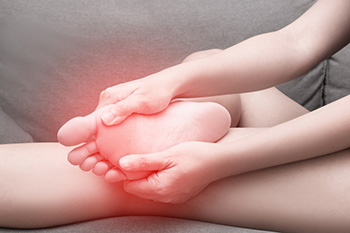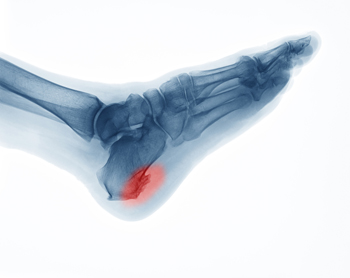Connect With Us
Blog
Items filtered by date: October 2024
Choosing the Right Ankle Brace

Finding the right ankle brace after an injury depends on the type of injury incurred, the level of instability it caused, and amount of support needed. Lace-up ankle braces offer adjustable support and a snug fit, making them a common choice for people with mild ankle instability. Stirrup braces provide more rigid support, with a plastic shell that stabilizes the joint, ideal for moderate injuries. Hinged ankle braces offer maximum stability and allow for a better range of motion, often used for severe injuries or post-surgery recovery. Compression braces, made of flexible material, reduce swelling and provide light support. Hybrid braces combine certain features, offering customized stability. Each type of ankle brace has advantages, like support and pain reduction, but may also restrict motion or cause discomfort if not properly fitted. A podiatrist can assess your ankle injury, recommend the best brace for your needs, and ensure it fits properly to avoid complications. If you have an ankle injury and need a brace, it is suggested that you make an appointment with a podiatrist for an exam and evaluation.
Ankle pain can be caused by a number of problems and may be potentially serious. If you have ankle pain, consult with Gabe Rodriguez, DPM from Sioux Falls Foot Specialist. Our doctor will assess your condition and provide you with quality foot and ankle treatment.
Ankle pain is any condition that causes pain in the ankle. Due to the fact that the ankle consists of tendons, muscles, bones, and ligaments, ankle pain can come from a number of different conditions.
Causes
The most common causes of ankle pain include:
- Types of arthritis (rheumatoid, osteoarthritis, and gout)
- Ankle sprains
- Broken ankles
- Achilles tendonitis
- Achilles tendon rupture
- Stress fractures
- Bursitis
- Tarsal tunnel syndrome
- Plantar fasciitis
Symptoms
Symptoms of ankle injury vary based upon the condition. Pain may include general pain and discomfort, swelling, aching, redness, bruising, burning or stabbing sensations, and/or loss of sensation.
Diagnosis
Due to the wide variety of potential causes of ankle pain, podiatrists will utilize a number of different methods to properly diagnose ankle pain. This can include asking for personal and family medical histories and of any recent injuries. Further diagnosis may include sensation tests, a physical examination, and potentially x-rays or other imaging tests.
Treatment
Just as the range of causes varies widely, so do treatments. Some more common treatments are rest, ice packs, keeping pressure off the foot, orthotics and braces, medication for inflammation and pain, and surgery.
If you have any questions, please feel free to contact our office located in Sioux Falls, SD . We offer the newest diagnostic and treatment technologies for all your foot care needs.
Reasons for Ball of the Foot Pain

Pain in the ball of the foot, known as metatarsalgia, can develop from increased pressure, injuries, or anatomical issues. Metatarsalgia often occurs from running, wearing high heels, or sports that place stress on the forefoot. Conditions like bunions, hammertoes, and high arches can also contribute to the pain by altering the alignment of the metatarsal bones. Additionally, nerve conditions, such as Morton’s neuroma, and issues with the plantar plate ligament can lead to pain and discomfort in the ball of the foot. Symptoms include sharp or aching pain, swelling, or a feeling of stepping on a small object. Addressing this pain requires understanding the underlying cause, which a podiatrist can diagnose through a thorough physical examination and imaging tests, if needed. Treatment may involve modifying footwear, prescribing custom orthotics, or considering other methods that help relieve pressure. If you have pain in the ball of your foot, it is suggested that you schedule an appointment with a podiatrist for an exam and treatment.
Foot Pain
Foot pain can be extremely painful and debilitating. If you have a foot pain, consult with Gabe Rodriguez, DPM from Sioux Falls Foot Specialist. Our doctor will assess your condition and provide you with quality foot and ankle treatment.
Causes
Foot pain is a very broad condition that could be caused by one or more ailments. The most common include:
- Bunions
- Hammertoes
- Plantar Fasciitis
- Bone Spurs
- Corns
- Tarsal Tunnel Syndrome
- Ingrown Toenails
- Arthritis (such as Gout, Rheumatoid, and Osteoarthritis)
- Flat Feet
- Injury (from stress fractures, broken toe, foot, ankle, Achilles tendon ruptures, and sprains)
- And more
Diagnosis
To figure out the cause of foot pain, podiatrists utilize several different methods. This can range from simple visual inspections and sensation tests to X-rays and MRI scans. Prior medical history, family medical history, and any recent physical traumatic events will all be taken into consideration for a proper diagnosis.
Treatment
Treatment depends upon the cause of the foot pain. Whether it is resting, staying off the foot, or having surgery; podiatrists have a number of treatment options available for foot pain.
If you have any questions, please feel free to contact our office located in Sioux Falls, SD . We offer the newest diagnostic and treatment technologies for all your foot care needs.
What Causes Heel Spurs?

Heel spurs, known medically as calcaneal spurs, are bony protrusions that form on the heel bone, or calcaneus. There are two primary types, which are known as inferior calcaneal spurs, developing on the bottom of the heel, and posterior calcaneal spurs, located at the back of the heel. These spurs often arise from repetitive stress on the foot, commonly from activities that involve running or walking on hard surfaces. Over time, this stress can lead to inflammation of the surrounding tissues, particularly the plantar fascia, resulting in pain and discomfort. Symptoms of heel spurs typically include localized pain, especially during initial steps after resting, and tenderness when pressure is applied to the heel. If you have heel pain, it is suggested that you consult a podiatrist who can accurately diagnose the cause and provide appropriate treatment.
Heel spurs can be incredibly painful and sometimes may make you unable to participate in physical activities. To get medical care for your heel spurs, contact Gabe Rodriguez, DPM from Sioux Falls Foot Specialist. Our doctor will do everything possible to treat your condition.
Heels Spurs
Heel spurs are formed by calcium deposits on the back of the foot where the heel is. This can also be caused by small fragments of bone breaking off one section of the foot, attaching onto the back of the foot. Heel spurs can also be bone growth on the back of the foot and may grow in the direction of the arch of the foot.
Older individuals usually suffer from heel spurs and pain sometimes intensifies with age. One of the main condition's spurs are related to is plantar fasciitis.
Pain
The pain associated with spurs is often because of weight placed on the feet. When someone is walking, their entire weight is concentrated on the feet. Bone spurs then have the tendency to affect other bones and tissues around the foot. As the pain continues, the feet will become tender and sensitive over time.
Treatments
There are many ways to treat heel spurs. If one is suffering from heel spurs in conjunction with pain, there are several methods for healing. Medication, surgery, and herbal care are some options.
If you have any questions feel free to contact our office located in Sioux Falls, SD . We offer the latest in diagnostic and treatment technology to meet your needs.
Determining a Need for Orthotics

Determining if orthotics can help you often starts by evaluating signs of imbalance or improper foot mechanics. If your shoes wear unevenly, typically on one side, it can indicate poor alignment or overpronation, both of which orthotics can address. Frequent ankle sprains suggest instability that orthotics can help stabilize. Chronic foot, heel, knee, or low back pain may stem from improper foot function, and custom orthotics can provide support and improve alignment, relieving pressure on joints. If your toes are not straight or your feet point excessively inward or outward, orthotics may correct these issues by guiding your feet into proper alignment. If you think you might benefit from orthotics, it is suggested that you visit a podiatrist for an evaluation, foot and gait analysis, and determination if orthotics are right for you.
If you are having discomfort in your feet and would like to try orthotics, contact Gabe Rodriguez, DPM from Sioux Falls Foot Specialist. Our doctor can provide the care you need to keep you pain-free and on your feet.
What Are Orthotics?
Orthotics are inserts you can place into your shoes to help with a variety of foot problems such as flat feet or foot pain. Orthotics provide relief and comfort for minor foot and heel pain but can’t correct serious biomechanical problems in your feet.
Over-the-Counter Inserts
Orthotics come in a wide variety of over-the-counter inserts that are used to treat foot pain, heel pain, and minor problems. For example, arch supports can be inserted into your shoes to help correct overarched or flat feet, while gel insoles are often used because they provide comfort and relief from foot and heel pain by alleviating pressure.
Prescription Orthotics
If over-the-counter inserts don’t work for you or if you have a more severe foot concern, it is possible to have your podiatrist prescribe custom orthotics. These high-quality inserts are designed to treat problems such as abnormal motion, plantar fasciitis, and severe forms of heel pain. They can even be used to help patients suffering from diabetes by treating foot ulcers and painful calluses and are usually molded to your feet individually, which allows them to provide full support and comfort.
If you are experiencing minor to severe foot or heel pain, it’s recommended to speak with your podiatrist about the possibilities of using orthotics. A podiatrist can determine which type of orthotic is right for you and allow you to take the first steps towards being pain-free.
If you have any questions please contact our office located in Sioux Falls, SD . We offer the newest diagnostic and treatment technologies for all your foot and ankle needs.
Gout Pain Can Be Managed
Symptoms of Stress Fractures of the Feet

Stress fractures of the feet and ankles are tiny cracks in the bones that result from repetitive stress or overuse, rather than from a single traumatic event. They commonly occur in athletes, runners, or individuals who suddenly increase their physical activity. The bones most affected are the metatarsals in the foot and the tibia near the ankle. Symptoms of a stress fracture include localized pain that worsens with activity, swelling, and tenderness to touch. The pain may decrease with rest but return during weight-bearing activities. Diagnosis typically involves a physical exam and imaging tests like X-rays or MRI scans. Treatment includes rest, and In severe cases, crutches or surgery may be necessary. Early diagnosis and treatment are important to prevent the fracture from worsening and to ensure a full recovery. If you believe you have endured a foot or ankle stress fracture, it is suggested that you schedule an appointment with a podiatrist for an accurate diagnosis and care.
Stress fractures occur when there is a tiny crack within a bone. To learn more, contact Gabe Rodriguez, DPM from Sioux Falls Foot Specialist. Our doctor can provide the care you need to keep you pain free and on your feet.
How Are They Caused?
Stress fractures are the result of repetitive force being placed on the bone. Since the lower leg and feet often carry most of the body’s weight, stress fractures are likely to occur in these areas. If you rush into a new exercise, you are more likely to develop a stress fracture since you are starting too much, too soon. Pain resulting from stress fractures may go unnoticed at first, however it may start to worsen over time.
Risk Factors
- Gender – They are more commonly found in women compared to men.
- Foot Problems – People with unusual arches in their feet are more likely to develop stress fractures.
- Certain Sports – Dancers, gymnasts, tennis players, runners, and basketball players are more likely to develop stress fractures.
- Lack of Nutrients – A lack of vitamin D and calcium may weaken the bones and make you more prone to stress fractures
- Weak Bones – Osteoporosis can weaken the bones therefore resulting in stress fractures
Stress fractures do not always heal properly, so it is important that you seek help from a podiatrist if you suspect you may have one. Ignoring your stress fracture may cause it to worsen, and you may develop chronic pain as well as additional fractures.
If you have any questions, please feel free to contact our office located in Sioux Falls, SD . We offer the newest diagnostic and treatment technologies for all your foot care needs.

